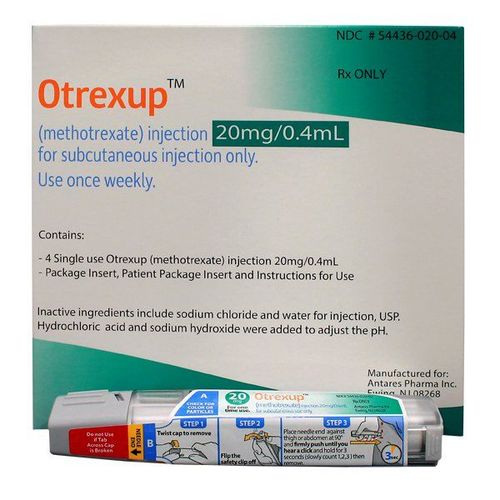This is an automatically translated article.
Psoriasis is a common autoimmune disease. In addition to immunosuppressive drugs, adults with psoriasis can be treated with Alefacept when certain conditions are met. So what is Alefacept and how should it be used?
1. What is Alefacept?
Alefacept belongs to the group of immunosuppressants, which is essentially a recombinant human protein. Alefacept binds to CD2 on T lymphocytes, thereby preventing the activation and reduction of T cells, and inhibits the interaction between LFA-3 on antigen-presenting cells and CD2.
Alefacept may decrease the number of CD2+ T cells (mainly CD45RO+ T cells), presumably resulting from the formation of a bridge between CD2 on target lymphocytes and the Fc receptor on Immunoglobulin cells. cytotoxic cells (such as natural cell death).
The effect of Alefacept on reducing the total number of circulating lymphocytes is dose dependent and mainly affects the activation of CD4+ and CD8+ T cells (i.e. CD4+ CD45RO+ and CD8+ CD45RO+ T cells).
In addition, Alefacept may also affect the activation and number of non-T cells, because CD2 is expressed at low levels on the surface of naturally dying cells and some cells. bone marrow B cells.
2. Indications and contraindications of the drug Alefacept
Uses of Alefacept are indicated in the treatment of moderate to severe chronic psoriasis in adults suitable for systemic therapy or phototherapy. Note that Alefacept should not be used concurrently with other immunosuppressive drugs.
Besides, Alefacept is not used in the following cases:
Patients with HIV virus; Are allergic to Alefacept or any of the ingredients in this product; People at high risk for malignancies (cancer); CD4 T-lymphocyte count below normal; Breastfeeding women.
3. Instructions for dosage and how to use Alefacept
3.1. Dosage of Alefacept The recommended dose of Alefacept for the treatment of psoriasis in adults is as follows:
Intravenous dose of 7.5 mg weekly or intramuscularly 15 mg weekly. The duration of using Alefacept is 12 consecutive weeks with the above dose. Alternatively, a 12-week course of Alefacept can be repeated if the CD4+ T-cell count is within the normal range and it has been more than 12 weeks since the end of the previous course of treatment; Before starting treatment with Alefacept, patients should have their CD4+ cell counts monitored, then every 2 weeks during the 12-week course of treatment. When the CD4+ T-cell count is lower than 250/mm3, the Alefacept injection is still maintained and CD4+ monitoring weekly. Discontinue Alefacept when CD4+ T cell count remains below 250/m3 for 1 month. Recommended dose of Alefacept for children over 6 years of age and adolescents:
Safety and efficacy studies have not been conducted in children under 18 years of age. Dosage of Alefacept in some other populations:
Elderly: No dosage adjustment of Alefacept is necessary as there is no overall difference in safety or efficacy compared to younger patients, but more is still needed. reliable studies to rule out important differences. Although no dose adjustment is required, the use of Alefacept in the elderly requires caution due to the risk of onset of infections and some malignancies; Renal failure, liver failure: There is no information on the dosage of Alefacept in this group of subjects. 3.2. How to use Alefacept Alefacept is a drug that is prepared for intramuscular or intravenous injection; Medical staff should only prepare the medicine just before the time of use, and at the same time must destroy the medicine if it is not used within 4 hours; Dilute only Alefacept with the solvent provided by the manufacturer with the product. When mixing, gently swirl the drug and solvent mixture for about 2 minutes to completely dissolve. Be careful not to shake the vial and avoid vigorous stirring to avoid creating too many air bubbles; The reconstituted solution of Alefacept should be clear, colorless to slightly yellow, and completely soluble. Absolutely do not use when the drug is discolored, cloudy or not completely dissolved; Alefacept is administered once weekly as a rapid intravenous injection (less than 5 seconds) or intramuscularly for a 12-week regimen. With intramuscular injection, medical staff need to change injection sites and avoid injecting in areas where the skin is tender, bruised, red, or hard.
4. Side effects of the drug Alefacept
Common side effects of Alefacept:
Sore throat, cough; Dizzy; Nausea ; Itchy; Muscle pain; Chills; Pain or swelling at the injection site; Cardiac arrhythmia, myocardial infarction; Hypersensitivity reactions; Acute infection. Uncommon side effects of Alefacept:
Decreased CD4+ and CD8+ T lymphocyte counts; Asymptomatic elevation of liver enzymes, fatty liver, hepatitis and severe liver failure; Increased risk of malignancies, especially basal cell or squamous cell cancers of the skin.
5. Some notes when using Alefacept
Side effects causing a decrease in white blood cell count, including a decrease in the number of CD4+ and CD8+ T cells of Alefacept, occur depending on the dose used; Alefacept is not indicated for treatment when the patient has a CD4+ level below normal; The risk of malignancies (such as basal cell skin cancer or squamous cell lymphoma or other solid tumours) is increased with the use of Alefacept, so it should be used with caution in people with a history of the disease. management of malignancy and drug discontinuation if malignancies develop; The risk of infection with Alefacept is higher than usual, so it should not be used in patients with severe infections (including HIV infection). This effect requires careful monitoring of the patient for signs of infection during and after treatment with Alefacept ; Hypersensitivity reactions such as urticaria, angioedema... have been reported with the use of Alefacept. Therefore, in the event of a serious hypersensitivity reaction, Alefacept should be discontinued immediately and appropriate treatment instituted; Alefacept should not be used concurrently with other immunosuppressive agents or phototherapy due to the risk of excessive immunosuppression; The safety and efficacy of live virus vaccination in patients receiving Alefacept have not been reported; Increased liver enzymes, increased risk of fatty liver, hepatitis, decompensated cirrhosis or liver failure... are side effects that have been reported with Alefacept. Therefore, it is necessary to evaluate and monitor the manifestations of liver damage in users of this product, and discontinue Alefacept when there is clinically important liver injury; Alefacept can be used on pregnant women; The ability of Alefacept to be distributed into breast milk is not known, so mothers should discontinue nursing while using this drug or discontinue the drug if breast-feeding; Precautions while driving & operating machines: No studies on the effects on the ability to drive and use machines have been performed with Alefacept; Missed dose and management: Alefacept is used by medical staff so patients are less likely to miss a dose; Overdose and management: There is no information on the maximum tolerated dose of Alefacept in humans. When using more than the recommended dose and having abnormal symptoms, the main treatment is general supportive measures because there is no specific antidote.
6. Drug interactions of Alefacept
To date, there have been no formal studies on drug interactions with Alefacept.
Alefacept should not be used concurrently with other immunosuppressive drugs because of the risk of excessive immunosuppression, such as Abatacept, Adalimumab, Aldesleukin, Alemtuzumab, Altretamine, Amsacrine, Baricitinib, Cisplatin... The therapeutic efficacy of human anti-anthrax immune globulin may be reduced when used in combination with Alefacept. The risk or severity of adverse events may be increased when Alefacept is combined with antiepileptic drugs such as Carbamazepine or Phenytoin. Do not get vaccinated with a live virus vaccine while using Alefacept .
Please dial HOTLINE for more information or register for an appointment HERE. Download MyVinmec app to make appointments faster and to manage your bookings easily.













